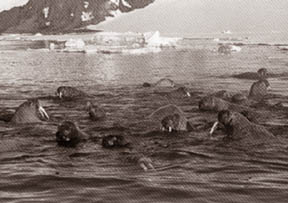|
observer |
|
|
|
|
|
OTHER LINKS |

|

|

|
From AbroadMelting sea ice, a danger to walrusesArctic researchers who discovered a surprising number of abandoned baby walruses say melting sea ice may be the culprit, according to a study in a recent issue of Aquatic Mammals. During an icebreaker cruise in the Canada basin two years ago, researchers measured an unusually warm mass of water - as high as 44 degrees fahrenheit, moving into the area from the Bering Sea to the south. This warm water may have rapidly melted seasonal sea ice over the shallow continental shelf north of Alaska, the study said. They also found nine lone and possibly abandoned walrus calves in the area, an 'unprecedented (unparalleled) number' for walruses, since mothers tend to stay with their calves for two years.
"We were on a station for 24 hours, and the calves would be swimming around us, crying. We couldn't rescue them," said team member Carin Ashjian, a biologist at Woods Hole Oceanographic institution. Sea ice offers foraging (searching for food) walruses a place to rest. Mothers leave their calves on the ice while they dive to feed on animals on the sea floor such as crabs and clams. But rising ocean temperatures may be forcing the walrus mothers to abandon their young as they follow the rapidly retreating ice edge north to colder waters, the study said. Without their mothers, the calves are likely to drown or starve, according to the research team. "The young can't forage for themselves," Ashjian said "They don't know how to eat." Sightings of solo walrus calves far from the shore have not been reported before, and suggest increased polar warming may take a toll on the walrus population, the study said. "If walruses and other ice associated marine mammals cannot adapt to caring for their young in shallow waters, without sea ice being available as a resting platform between dives to the sea floor, a significant population decline of this species could occur," the researchers concluded. Funded by the National Science Foundation, the study investigated the impact of global climate change on the oceanic eco-system over the continental shelf of Alaska. - Reuters Learning curveClassic, western or cow-boy films often depict, though unintentionally, how the frontier days fade into a groundswell (wave-like) for the hi-tech era. All the striking visuals are there: the telegraph, printing press, and railroad. And this writer fancies another thing. The style of letters (fonts) used in the signboards of stores and saloons, and notably in those legendary WANTED posters, are fashioned after the cowboy lifescapes. This tells us something about the beginnings of the printed word.
Many of the innumerable (too many to be counted) type-faces available in the computerised printing technology took shape from current lifestyles, and hi-tech themes and structures. It is true that languages, unlike printing and reading options, don't originate in a few years, but they too draw heavily from surroundings. Somebody said, alluding (referring) to a new research: "When you pick up a pen and write, you're not simply scratching down a set of abstract marks, but representing the trees, mountains and horizons that surrounded your forebears". That is, people seem to choose their visual signs to conform to the contours of nature's visuals. Looking at more than 100 writing systems throughout history, the research concluded that all letters, and also symbols like trademarks, share nature-bound global patterns and frequencies. You see "a similar signature" in the configuration (shape) of all classes of human visual signs, and this hints at underlying thought-forces governing the systems involved. Stretch the letters, squeeze them and play around with them, and you are still left with basically the same number of links and junctions. This is, of course, a simplistic view at the moment. Another interesting thing is that, because of our skill in visually processing these signs, we choose shapes for ease of visual recognition at the expense of manual efficiency. These might not be the most efficient shapes to mark on a surface. The theory doesn't make instant biological sense. What could have been the primary evolutionary impulse and first impressions of our ancestors when they looked at the scenery around them? If you put yourself in that critical phase in our evolutionary past, you can see that we had to find food, and run away from, or fight, our predators, and we had evolved to handle such critical lines - not just to look at scenery as scenery only. - The New Sunday Express |









